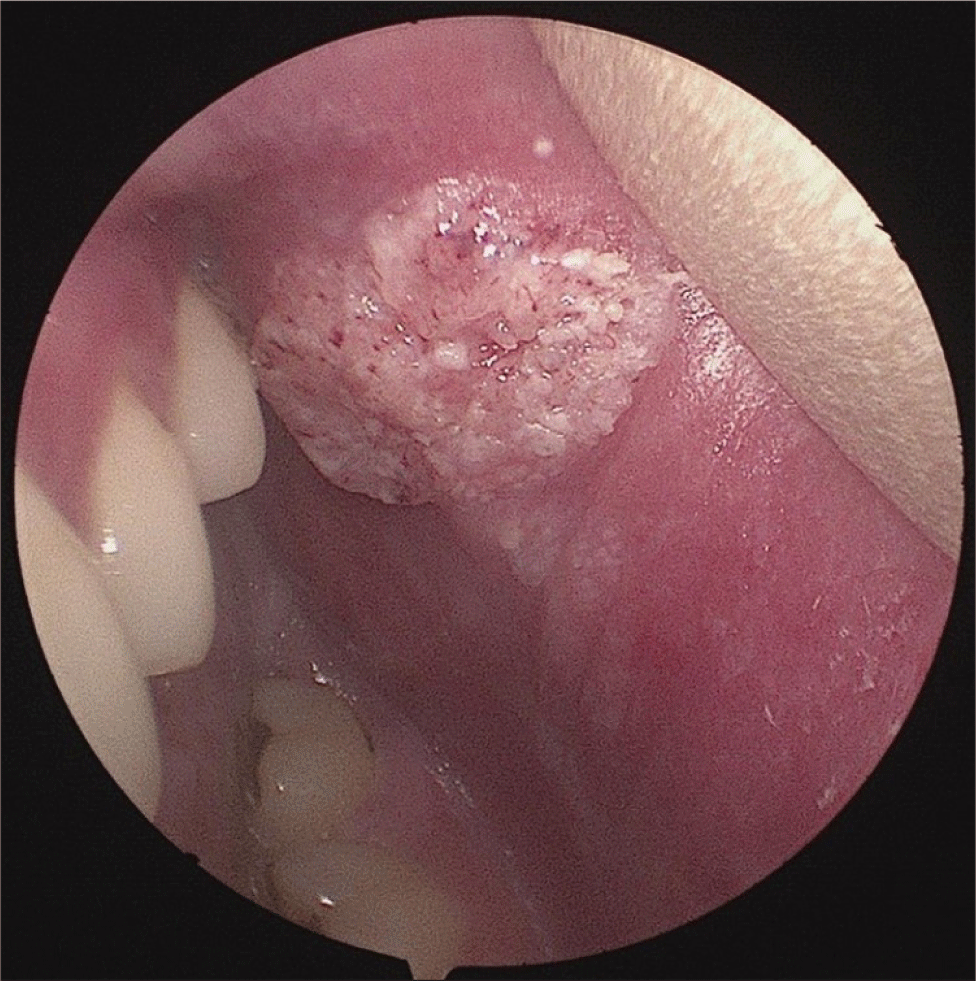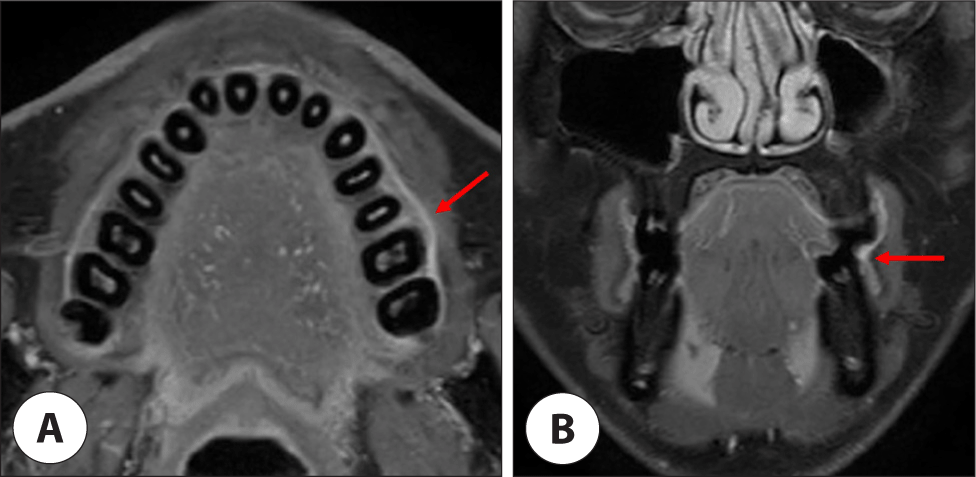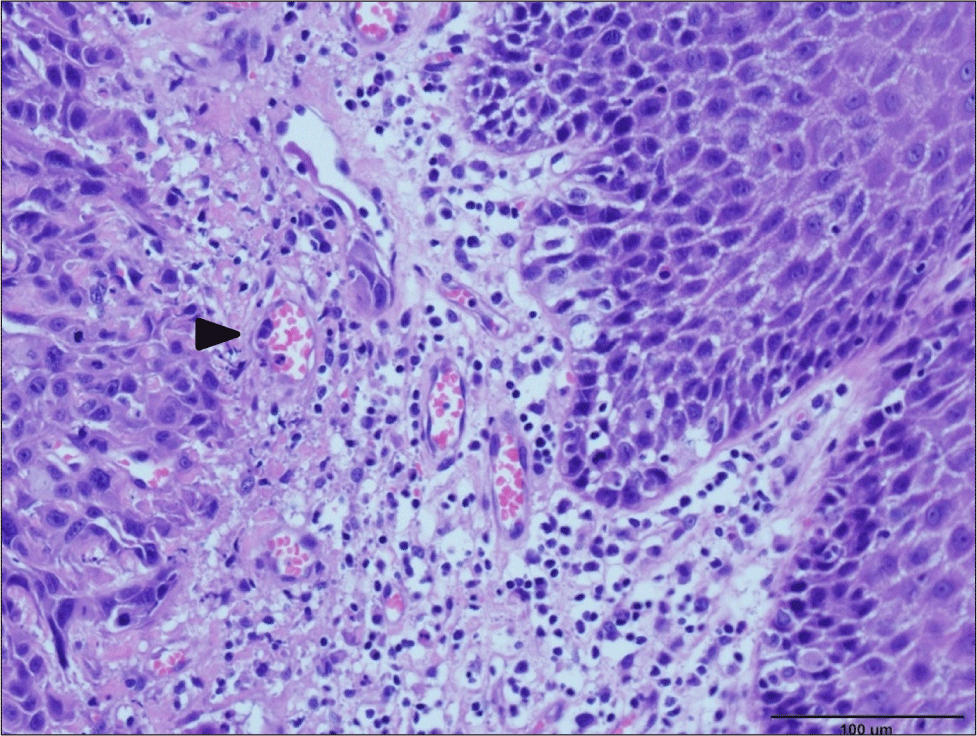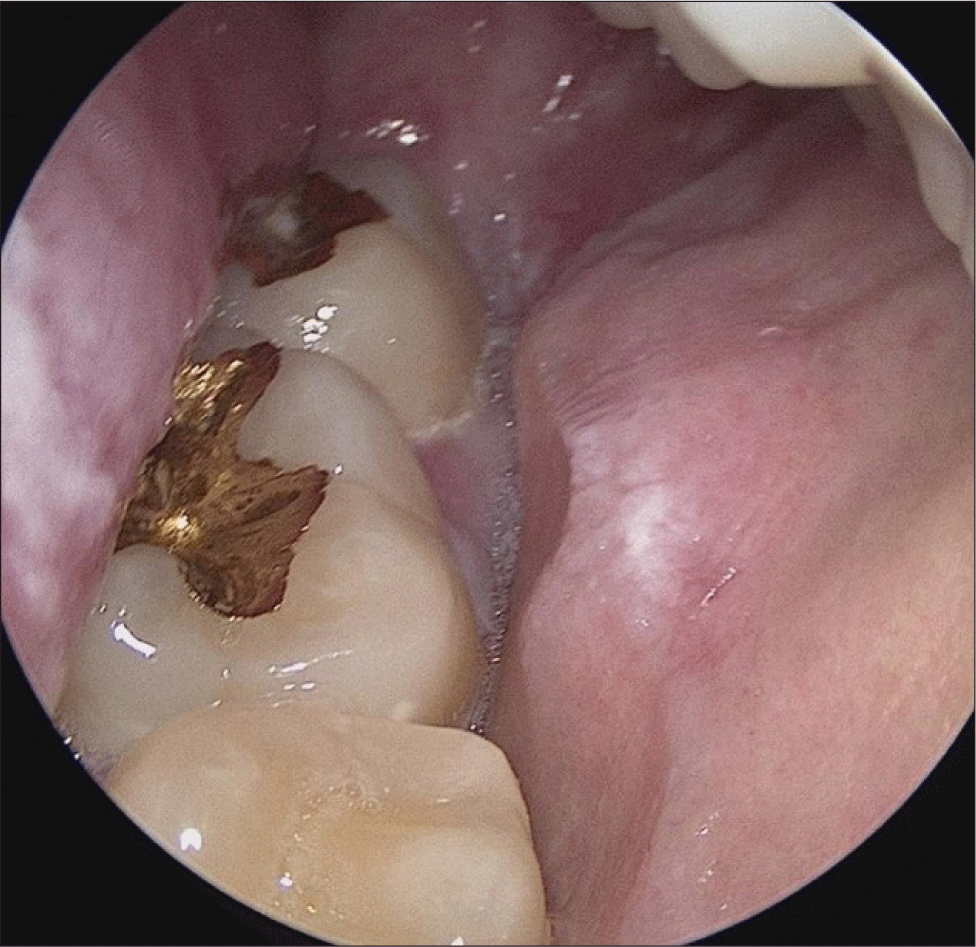Introduction
Fanconi anemia (FA) is an autosomal recessive genetic disease that occurs in approximately one in 200,000 people.1) Patients with FA are at higher risk of developing head and neck cancer than the general population due to chromosomal instability and defects in the DNA repair process.2) The onset, etiology, and prognosis of head and neck cancer in patients with FA is different from that in the general population.3) Below, we describe a patient with FA who was diagnosed with buccal cancer. This patient had received a prior bone marrow transplant.
Case
A 28-year-old man visited our clinic due to a whitish patch in the left buccal mucosa. He had been diagnosed with FA previously and received a stem cell transplant in 2004. He had no history of smoking or alcohol consumption in his social history. He exhibited a characteristically small stature related to FA anemia but had no issues with intelligence. Physical examination revealed a whitish patch (2×2 cm) with shallow ulceration in the left buccal area (Fig. 1). A punch biopsy was performed at the same visit, and pathological examination confirmed a well-differentiated squamous cell carcinoma (SCC). Magnetic resonance image (MRI) scans of the neck were taken to check for tumor extension and nodal metastases. Radiology showed that the tumor was confined to buccal mucosa, with no metastases to cervical nodes (Fig. 2). A positron emission tomography scan revealed no distant metastases. Therefore, we diagnosed the patient with buccal cancer (cT1N0M0, stage 1) and planned buccal wide excision, ipsilateral elective supra-omohyoid neck dissection, and an inguinal free flap for reconstruction. Wide excision was performed to the buccinator muscle level, and a frozen biopsy confirmed that the margin was tumor-free. Pathologic analyses revealed that the buccal lesion was moderately-differentiated SCC, and that the depth of invasion was 0.2 cm. Although the surgically resected margins were clear, pathologic examination of the primary site suggested suspected lympho-vascular invasion (Fig. 3). A single nodal metastases was confirmed at neck level Ib. In a multidisciplinary consultation, considering the risk of malignancy, the patients young age, FA, and the pathologically suspected lympho-vascular invasion, It was decided to proceed adjuvant intensity modulated radiation therapy (IMRT) only to the left buccal and ipsilateral neck fields. Also adjuvant chemotherapy was discussed, but it was excepted due to the potential for severe side effects, such as bone marrow suppression. The patient has been under outpatient follow-up for 1 year, with no loco-regional recurrence or severe complications (Fig. 4).



Discussion
FA is a rare autosomal recessive disease characterized clinically by bone marrow failure, congenital physical defects, and a high predisposition to malignancy.4) Any one of multiple germline mutations in FA-related genes can cause FA.2) These germline mutations increase DNA instability and cause defects in the DNA repair response. For this reason, all patient with FA have a high risk of malignancy such as acute myeloid leukemia and SCC.2) The estimated incidence of head and neck squamous cell carcinoma (HNSCC) in patients with FA is 500–800-fold greater than that in the general population.5) Because notable advances in hematologic management of FA have increased the life expectancy of these patients, the risk of developing FA-associated HNSCC has also increased.5) Indeed, It was suggested that bone marrow transplantation increases the risk of HNSCC development of FA patients.6)
FA-associated HNSCC has a distinct prevalence, etiology, and more advanced clinical features than “general” HNSCC;3) for example, FA-associated HNSCC tends to occur earlier (median age at onset, 31years) than in the general population (median age at onset, 45 years).1) In addition, the early stage of FA-associated HNSCC is associated with nodal metastasis and frequent relapse.7) It also exhibits more aggressive clinical features; for example, the patient reported here had suspected lympho-vascular invasion at the primary site, leading to the confirmation of occult neck metastases. Unlike the role of Human papilloma virus (HPV) in general HNSCC patients, the effect of HPV on HNSCC patients with FA is still not clearly understood.8)
In this case, the cancer occurred at a much younger age than the average age of onset for HNSCC and there were no other risk factors such as smoking or drinking.
National Comprehensive Cancer Network (NCCN) guidelines for SCC of the oral cavity recommend surgery, radiation therapy (RT), and cisplatin based chemo-radiation therapy (CRT) as standard treatments;9) however, because FA impairs the DNA repair process, RT or CRT can have more severe and fatal adverse effects than in the general population.9) Therefore, surgical resection is the preferred primary therapy because patients tend to be more susceptible to chemo/radiation-induced toxicity.10) From the perspective of oncologic safety, the principle of performing surgery (which involves radical resection at the primary site, along with neck dissection where necessary) is not different between FA and non-FA HNSCC.11) After extensive radical resection, FA patents with HNSCC sometimes require microvascular free flap reconstruction to minimize the defects and preserve physiologic function.11,12)
If adjuvant RT or CRT are required, careful monitoring is necessary to minimize adverse effects.9) Moreover, to reduce radiation-induced toxicity and preserve surrounding normal tissues, IMRT may be a safer option.5) In this case, we suspected lympho-vascular invasion at the primary site; therefore, RT is recommended by the NCCN guidelines. The patients received adjuvant RT using the IMRT technique, along with careful observation after surgery.
Because FA impairs DNA repair responses, alkylating agents such as cisplatin can increase the risk of chemotoxicity and bone marrow failure.10) To avoid such fatal systemic side effects, alternative chemotherapy regimens such as cetuximab and tyrosine kinase inhibitors could be considered.10) However, further research into the efficacy of these drugs is needed.5)
FA-associated HNSCC shows rates of high loco-regional recurrence and aggressive clinical features; therefore, treatment strategies should be differentiated.11) If the primary site is operable, surgery should be the primarily consideration.10) Other treatment modalities such as RT and CRT should be performed after careful consideration, balancing loco-regional control and therapeutic toxicity.12) It is important that FA patients receive specialized medical care including oral hygiene care and regular screening for HNSCC.5)

